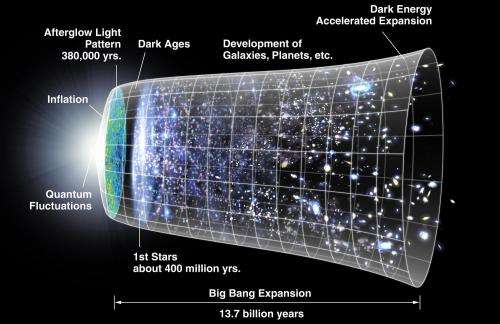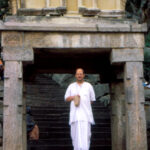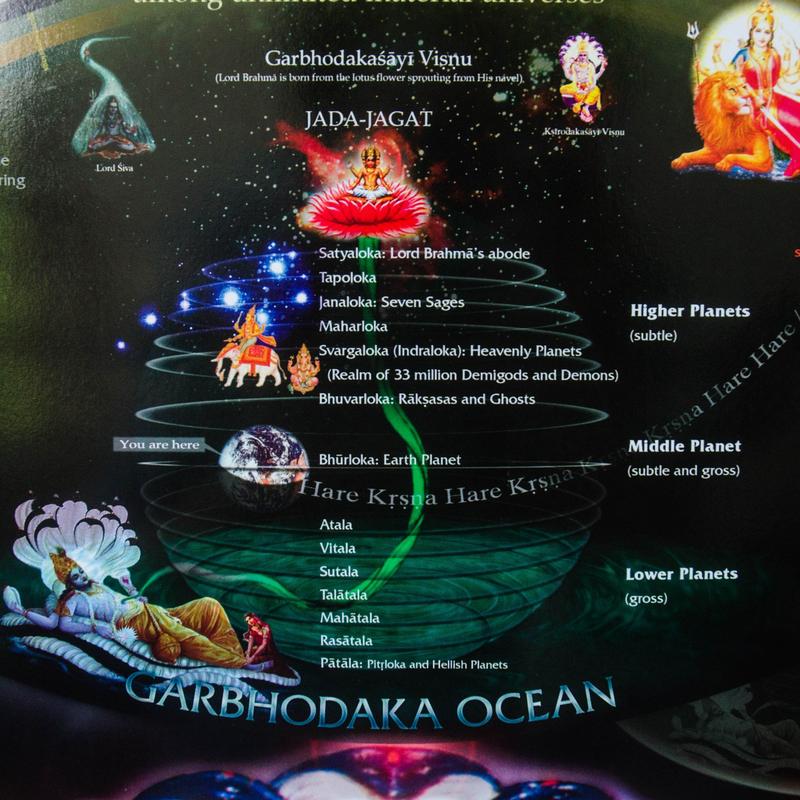Why Understand the Creation of the Universe
SCIENCE - SPIRITUALITY, 28 Oct 2024
Stephen Knapp (Sri Nandanandana dasa) – TRANSCEND Media Service

This is an artist’s concept of the metric expansion of space, where space (including hypothetical non-observable portions of the universe) is represented at each time by the circular sections. Note on the left the dramatic expansion (not to scale) occurring in the inflationary epoch, and at the center the expansion acceleration. The scheme is decorated with WMAP images on the left and with the representation of stars at the appropriate level of development. Credit: NASA
Why should we understand how the universe was created? Because it gives us a clearer understanding of where we have come from, where we are going, who and what we are, and what our purpose is here. There have been many scientific theories over the years about the origin of life and how the universe may have been created. However, science makes little comment on the purpose of the universe or the reason for life. But why would something come to be without a purpose? Once you consider that there is a purpose to life, the search for life’s origins may very well lead you into a different direction than simply trying to find an explanation for a mechanical or chemical process of creation. In this book we are going to deal with these points, and more.
We are going to take a look at a different approach to the origin of the universe, the Vedic approach. The difference between most scientists and the Vedic approach is that the Vedic system accepts a descending channel of knowledge coming from previous authorities. Scientists accept no prior authority, except for other scientists, and try to discover the mysteries of the universe through their own perceptions by various instruments, experiments, and the use of mathematical formulas to try to verify their theories. This is called the ascending process. However, if one should diligently take this process to its ultimate conclusion, one will reach the same line of thought as the descending method.
For example, in the 1930s, Sir James Jeans concluded in his book, The Mysterious Universe (1930), that the universe consists of pure thought, which means the creation must have been an act of thought. However, he felt that the “thinker” had to have been a mathematical thinker working outside the boundaries of time and space, which is part of His creation. Thus, the “thinker” had to have been “beyond what He created.” Sir Arthur Eddington also concluded in his book, The Nature of the Physical World (1935), that, “The stuff of the world is mind stuff.” In part, both of these theories are corroborated in the Vedic texts because it is described that the Supreme Creator produces the material world by His dreaming in yoga-nidra, His mystic slumber. Thus, the material creation is the Supreme Being’s dream, or a display of His thought energy. Furthermore, the Vedic literature describes how the Supreme Being exists outside the boundaries of the material manifestation from where He begins the process of creation. So, He is indeed “beyond what He created.”
It was also in the 1930s when scientists played with the idea that all life and consciousness began from a “primordial soup.” This would be a soup of all the necessary chemicals needed to produce a living cell that would somehow combine in just the right way to spark a living organism.
Another idea was the theory of the BIG BANG, that all creation started from a single point or particle. This particle had unlimited depth and weight that somehow exploded to produce the universe. This, however, is mathematically indescribable. It is called a singularity, which means it is impossible. Nonetheless, this theory, as with the theory of evolution, is often taken to be a fact, upon which many other theories become based. However, they do not explain from where or how the original particle appeared.
The theories of the primordial soup and BIG BANG depend on the idea that inert matter can randomly organize itself into complex structures and various species of life. That is the fundamental trouble with both of these theories: How can inert matter by itself develop the incredible molecular arrangements to produce even the simplest cell? Matter does not organize itself that way. In fact, it can be seen that matter, once put into some form of construction and then left alone, always deteriorates. As scientists develop newer instruments to take a closer look at cells, they understand how truly miraculous such a random occurrence could be. Thus, it becomes obvious that nature needs to be directed by some higher force or intelligence for such combinations of material ingredients to come together to produce life. This immediately nullifies Darwin’s theory of evolution. Even Darwin admitted that there were problems with his theory.
However, the modern theory and the Vedic description of evolution are similar, but there is one big difference. The modern theory teaches that one simple species produces another species through variations of genetic reproduction until we have a variety of progressively more complex life forms. The Vedic system, on the other hand, teaches that evolution starts in the opposite way. From a complex species, such as God, and then the devas or demigods who are the co-creators, and through the process of reproduction and genetic variations, there is a production of continually less complex species. This could be called the process of inverse evolution. However, the modern theory cannot explain why there are galaxies, or how the simplest of cells were formed. So there are many gaps in the modern theories of creation and evolution that are still waiting for further evidence to be solved. So why should science not look at the Vedic view as well?
My suggestion is that the assumption of a BIG BANG is the scientists interpretation of evidence that indicates an exceedingly sudden arise of material elements as they were manifested from the Supreme Being. The Supreme Creator is, of course, spiritual and would be undetectable and beyond observation in the material sense by our limited senses and ordinary instruments. Thus, there would be nothing that we could see to indicate His presence in the universe before the creation. So it may certainly look as if this universe did come from nothing. Nonetheless, the process of the sudden development of the stars, planets, and galaxies could have been similar to the ideas that the scientists have put forth.
The problem is that even if something like the BIG BANG did occur without the supervision of a higher authority, what you would really end up having is a universe filled with dust. Why would such solid planets, suns, stars, and galaxies form out of this floating dust? And there certainly has been no scientific explanation why there is consciousness that inhabits the millions of species of beings. How could a BIG BANG bring about consciousness? From where did it come? These things are not explained by science. So it is not unreasonable to consider other theories about how this universe came into being, and how there was a development of so many species of life that have consciousness.
Another problem is that trying to apply simple physical laws on complex phenomenon like the creation requires the use of assumptions and guesswork which make such scientific theories no better than superstitions, even if such ideas are supported by other scientists or mathematicians. Their conclusions are misleading. This is why scientists are always changing or updating their conclusions as they make new discoveries. If they did not have it right the first time, why should we think they may have it right later on? And they will never get it right if they have only one theory and simply try to make all of their evidence fit that theory. They need to look at other possibilities.
Furthermore, the whole idea of a random reorganization of matter directly opposes the second law of thermodynamics. This law states that as time goes on, there is an increase in entropy, which is an increase in the state of random disorder or deterioration. This means that without a higher intelligence to intercede in the steady disorganization of elements, the universe is in a constant state of gradual decline. This is directly opposite to the idea that matter could organize itself into increasingly complex systems of stars, planets, and galaxies, or even cells, bodies, and various species. So such an organization of matter after a BIG BANG could never have taken place, nor could a BIG BANG have occurred. How could there have been a single particle of unlimited depth and weight floating around in the void universe waiting to explode? Someone had to have put it there. And how could it have exploded into unlimited atoms that formed the universe? Such theories are simply more scientific myths. So how else could the universe have been formed and from where does consciousness come?
First of all, consciousness does not come from a combination of chemicals. Consciousness is a non-material energy. Thus, consciousness exists before, during, and after the material creation. This means that the origin of the material cosmos and all life within it must also be consciousness, a Supreme Consciousness from whom come all other forms of consciousness that take up residence in the varieties of material bodies or species found in this material creation. This origin must also have intelligence and the ability to design in order to make the various combinations of elements come together to form even the simplest of cells. A single cell is formed by a combination of 300 amino acids that come together in a certain chain or pattern. Even scientists cannot figure out how that happened. And nature cannot do it by itself, as explained above. So there had to have been a guiding Creator to put this all together.
So if there is such a Supreme Creator with consciousness and intelligence, it is also quite possible that He would allow a way for us to communicate with Him. It is also quite possible that He provides us with the knowledge we need for us to know how to do this and to understand what we are and the purpose of life. For example, according to Vedic science, as the Supreme Creator creates the cosmos, the creative potency descends among other beings who are created, called demigods in the Vedic system, to assist the Supreme in manifesting the material worlds. So, the Supreme expands Himself and also creates positions within the material cosmos which are taken by co-creators or demigods who assist in creating and maintaining the material manifestation. They also help distribute the spiritual knowledge among all others. This is the descending process of acquiring knowledge by which we understand the mysteries of life. It is the information provided by the Supreme Creator that descends through the ancient sages and scriptures, and His pure representatives. In this way, we can learn about the universe and its purpose rather than trying to understand it only by analyzing minute cells and parts of the cosmos, the way of modern science.
We need to be aware that scientists may continue to try to find the cause and origin of the universe for thousands of years, but they will not find it. They will never find the source by examining the elements within the universe. They may get clues through such a process and realize that all molecules and elements are like signs that point to a Creator, but you have to reach the Creator to understand how everything happened. Therefore, the reason why they will never find the cause of the universe by only using this method is that the original cause of the creation exists OUTSIDE the universe. It is like analyzing the elements within a house to find its cause when the designer lives somewhere else outside the house. Thus, until the scientists can reach the Creator through spiritual understanding, examining the universe to find its cause or source is like a maze that has no end.
Our premise, on the other hand, is that all life comes from God. Almost every religion accepts this. Unfortunately, the problem is that most religions and traditions provide only a short and unscientific story or allegory of the universal creation. However, the Vedic literature, such as the Srimad-Bhagavatam, explains that the universal creation is but an expansion or a development from the original spiritual elements. These exist prior to, during, and after the material creation. By understanding the Supreme Creator and the spiritual nature, the cause of the material manifestation can be understood. Not the other way around.
The universe started in a state of perfect simplicity. The design of this universe comes from that dimension of ultimate cause and simplicity, which is that of the spiritual. This is beyond the material strata and where the cause of the universe and the seed of its manifestation exists. The Vedic literature points the way to this region and presents the blueprints of the universe and all life within.
The energies of matter and spirit are energies that vibrate at different frequencies and manifest on diverse levels. However, they both originate from the same source, which is consciousness, the pure consciousness of the Supreme Being. Yet, the spiritual strata is eternal while the material is temporary. Thus, the material plane is subservient to, and pervaded by, the unlimited spiritual energy. It is this spiritual energy which is the foundation of the material realm and interacts with it in all phases, although unbeknownst to those who are spiritually unaware. To know the universe is to know that each atom is but a reflection of the Supreme Creator’s potency.
The Vedic literature explains how the material elements are created, and how they make systems and arrangements of forms from planets to various species of life. It describes how the material energy is directed and maintained to prevent it from sliding into deterioration, and how it is finally destroyed or wrapped up to merge back into the spiritual atmosphere. So in this book we will show by Vedic descriptions how the temporary material cosmic creation comes from the Supreme Being and the eternal spiritual nature, and what we are supposed to do while living here.
__________________________________________________
 Stephen Knapp (Sri Nandanandana dasa) has dedicated himself to spreading the deepest and most practical levels of spiritual knowledge about the soul–our real identity. Though this world may give us numerous challenges, when we rise above the basic materialistic view and its limited search for solutions, our evolutionary development on all levels greatly accelerates. By recognizing that we are all spiritual beings who are, basically, attempting to achieve the same essentials for our existence–namely love, acceptance, harmony, peace, and happiness, not to mention the ordinary needs of food, water, clothing and shelter–we can reach a new level of cooperation with each other. Stephen has written many books on this and related subjects and studied with A. C. Bhaktivedanta Swami Prabhupada becoming initiated into the spiritual line of Brahma-Madhava-Gaudiya sampradaya. He is also president of the Vedic Friends Association. srinandan@aol.com
Stephen Knapp (Sri Nandanandana dasa) has dedicated himself to spreading the deepest and most practical levels of spiritual knowledge about the soul–our real identity. Though this world may give us numerous challenges, when we rise above the basic materialistic view and its limited search for solutions, our evolutionary development on all levels greatly accelerates. By recognizing that we are all spiritual beings who are, basically, attempting to achieve the same essentials for our existence–namely love, acceptance, harmony, peace, and happiness, not to mention the ordinary needs of food, water, clothing and shelter–we can reach a new level of cooperation with each other. Stephen has written many books on this and related subjects and studied with A. C. Bhaktivedanta Swami Prabhupada becoming initiated into the spiritual line of Brahma-Madhava-Gaudiya sampradaya. He is also president of the Vedic Friends Association. srinandan@aol.com
Go to Original – stephen-knapp.com
Tags: Big Bang Theory, Cosmos, Creationism, Eternity, Evolution, History, India, Infinite, Mahabharata, Materialism, Spirit soul, Spiritual Science, Spirituality, Universe
DISCLAIMER: The statements, views and opinions expressed in pieces republished here are solely those of the authors and do not necessarily represent those of TMS. In accordance with title 17 U.S.C. section 107, this material is distributed without profit to those who have expressed a prior interest in receiving the included information for research and educational purposes. TMS has no affiliation whatsoever with the originator of this article nor is TMS endorsed or sponsored by the originator. “GO TO ORIGINAL” links are provided as a convenience to our readers and allow for verification of authenticity. However, as originating pages are often updated by their originating host sites, the versions posted may not match the versions our readers view when clicking the “GO TO ORIGINAL” links. This site contains copyrighted material the use of which has not always been specifically authorized by the copyright owner. We are making such material available in our efforts to advance understanding of environmental, political, human rights, economic, democracy, scientific, and social justice issues, etc. We believe this constitutes a ‘fair use’ of any such copyrighted material as provided for in section 107 of the US Copyright Law. In accordance with Title 17 U.S.C. Section 107, the material on this site is distributed without profit to those who have expressed a prior interest in receiving the included information for research and educational purposes. For more information go to: http://www.law.cornell.edu/uscode/17/107.shtml. If you wish to use copyrighted material from this site for purposes of your own that go beyond ‘fair use’, you must obtain permission from the copyright owner.
Read more
Click here to go to the current weekly digest or pick another article:
SCIENCE - SPIRITUALITY:
